Pyroligneous Acid Effects on Crop Yield and Soil Organic Matter in Agriculture—A Review
Abstract
1. Introduction
2. Materials and Methods
- Plant species;
- Yield data or increase;
- Plant biomass data or increase;
- SOM data or increase;
- TOC data or increase;
- Soil microbial biomass data or increase;
- Duration of the experiment;
- PA characteristics, including feedstock material, pyrolytic conditions, pH, and chemical composition;
- Type of application (i.e., foliar application or soil irrigation);
- Amount of application in concentration or recalculated to the application rate in t/ha;
- Frequency of application;
- Soil information (pH and classification);
- Growth conditions;
- Additional information was collected if the studies applied PA in combination with biochar.
3. Results
3.1. PA Effects on Yield and Biomass
3.2. PA Effects on Soil Organic Matter and Soil Carbon
4. Discussion and Conclusions
Supplementary Materials
Author Contributions
Funding
Data Availability Statement
Acknowledgments
Conflicts of Interest
Abbreviations
| PA | Pyroligneous acid |
| SOM | Soil organic matter |
| DOC | Dissolved organic carbon |
| TOC | Total organic carbon |
Appendix A

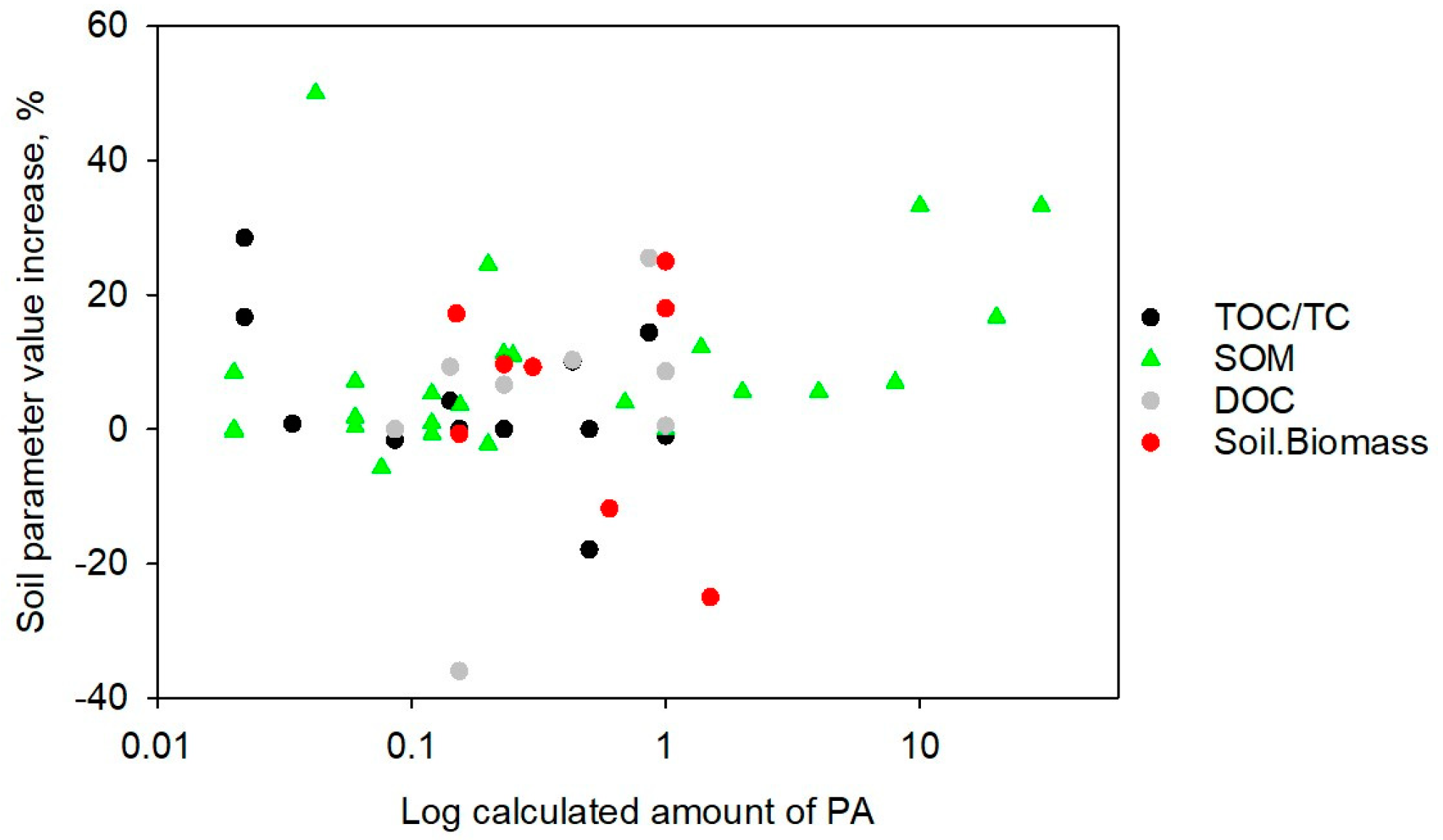

| Added Biochar | Yield Increase % Combination | Yield Increase % PA Application | Soil Parameter Increase % Combination | Soil Parameter Increase % PA application | Parameter |
|---|---|---|---|---|---|
| 2% | 36 | 2.4 | 20 | −1 | TOC |
| 1% | 15.3 | 2.3 | 14.6 | 0.8 | TOC |
| 1.50% | 4.75 | 18 | 90 | 50 | SOM |
| 0.50% | 0 | 11.2 | |||
| 0.50% | −8.7 | −3.5 | |||
| 7.5 t/ha | 15.9 | 11.2 | |||
| 7.5 t/ha | 5.2 | −1.3 | |||
| 0.04% | 62 | 2 | |||
| 5% | −14.9 | 46 | |||
| Seed coating | 20 | 19 | |||
| 1.50% | 166 | 56 | 160 | 4 | SOM |
| 3% | 220 | 113 | 351 | 12.3 | SOM |
| 1.50% | 35 | 28.5 | SOM | ||
| 1.50% | 133 | 16.7 | TOC | ||
| 15% | 40 | 40 | 315 | 11 | TOC |
| Average | 43.2 | 24.3 | 139.8 | 15.3 |
References
- Grewal, A.; Abbey, L.; Gunupuru, L.R. Production, prospects and potential application of pyroligneous acid in agriculture. J. Anal. Appl. Pyrolysis 2018, 135, 152–159. [Google Scholar] [CrossRef]
- Ferrarin, M.; Becagli, M.; Guglielminetti, L.; Cardelli, R. Wood distillate, a review over past application and future perspective on soil and plant research. Agrochimica 2022, 65, 17–24. [Google Scholar] [CrossRef]
- Sivaram, A.K.; Panneerselvan, L.; Mukunthan, K.; Megharaj, M. Effect of pyroligneous acid on the microbial community composition and plant growth-promoting bacteria (PGPB) in soils. Soil Syst. 2022, 6, 10. [Google Scholar] [CrossRef]
- Masum, S.M.; Malek, M.; Mandal, M.S.H.; Haque, M.N.; Akther, Z. Influence of plant extracted pyroligneous acid on transplanted aman rice. J. Expt. Biosci. 2013, 4, 31–34. [Google Scholar]
- Lee, J.K.; Park, H.J.; Cha, S.J.; Kwon, S.J.; Park, J.H. Effect of pyroligneous acid on soil urease, amidase, and nitrogen use efficiency by Chinese cabbage (Brassica campestris var. Pekinensis). Environ. Pollut. 2021, 291, 118132. [Google Scholar] [CrossRef]
- Seo, P.D.; Ultra, V.U., Jr.; Rubenecia, M.R.U.; Lee, S.C. Influence of herbicides-pyroligneous acids mixtures on some soil properties, growth and grain quality of paddy rice. Int. J. Agric. Biol. 2015, 17, 499–506. [Google Scholar] [CrossRef]
- Iacomino, G.; Idbella, M.; Staropoli, A.; Nanni, B.; Bertoli, T.; Vinale, F.; Bonanomi, G. Exploring the potential of wood vinegar: Chemical composition and biological effects on crops and pests. Agronomy 2024, 14, 114. [Google Scholar] [CrossRef]
- Zhang, Y.; Wang, X.; Liu, B.; Liu, Q.; Zheng, H.; You, X.; Sun, K.; Luo, X.; Li, F. Comparative study of individual and co-application of biochar and wood vinegar on blueberry fruit yield and nutritional quality. Chemosphere 2020, 246, 125699. [Google Scholar] [CrossRef]
- Fedeli, R.; Vannini, A.; Celletti, S.; Maresca, V.; Munzi, S.; Cruz, C.; Alexandrov, D.; Guarnieri, M.; Loppi, S. Foliar application of wood distillate boosts plant yield and nutritional parameters of chickpea. Ann. Appl. Biol. 2022, 182, 57–64. [Google Scholar] [CrossRef]
- Fedeli, R.; Vannini, A.; Guarnieri, M.; Monaci, F.; Loppi, S. Bio-based solutions for agriculture: Foliar application of wood distillate alone and in combination with other plant-derived corroborants results in different effects on lettuce (Lactuca sativa L.). Biology 2022, 11, 404. [Google Scholar] [CrossRef]
- El-Fawy, M.M.; Saeed, A.S.; Abou-Shlell, M.K.; Soliman, M.A.; Ali, E.F.; Issa, A.A.; Abo-Elyousr, K.A.M.; Imran, M.; El-Nagar, A.S. Effectiveness of biochar and wood vinegar from guava trees in controlling Fusarium verticillioides and enhancing growth and anatomical traits of maize (Zea mays L.). J. Plant Dis. Prot. 2024, 131, 2029–2043. [Google Scholar] [CrossRef]
- Zhou, H.; Fu, K.; Shen, Y.; Li, R.; Su, Y.; Deng, Y.; Xia, Y.; Zhang, N. Physiological and biochemical mechanisms of wood vinegar-induced stress response against tomato fusarium wilt disease. Plants 2024, 13, 157. [Google Scholar] [CrossRef]
- El-Fawy, M.M.; Abo-Elyousr, K.A.M.; Sallam, N.M.A.; El-Sharkawy, R.M.I.; Ibrahim, Y.E. Fungicidal effect of guava wood vinegar against colletotrichum coccodes causing black dot disease of potatoes. Horticulturae 2023, 9, 710. [Google Scholar] [CrossRef]
- Zhou, X.; Shi, A.; Rensing, C.; Yang, J.; Ni, W.; Xing, S.; Yang, W. Wood vinegar facilitated growth and Cd/Zn phytoextraction of sedum alfredii hance by improving rhizosphere chemical properties and regulating bacterial community. Environ. Pollut. 2022, 305, 119266. [Google Scholar] [CrossRef] [PubMed]
- Rogelio, R.M. Alternative growth ehancers for rice production: Usefulness of wood ainegar (PA) in irrigated rice (PSB Rc18). J. Biol. Agric. Healthc. 2018, 8, 82–98. [Google Scholar]
- Lee Sang-Chul, C.M.R.; Souvandouane, S.; Mintah, L.O.; Chung, I.; Son, T.K. Effects of mixed application of wood vinegar and herbicides on weed control, yield and quality of rice (Oryza sativa L.). Korean J. Crop Sci. 2007, 52, 387–392. [Google Scholar]
- Pangnakorn, U.; Watanasorn, S.; Kuntha, C.; Chuenchooklin, S. Application of wood vinegar to fermented liquid bio-fertilizer for organic agriculture on soybean. Asian J. Food Agro-Ind. 2009, 2, 189–196. [Google Scholar]
- Zulkarami, B.; Ashrafuzzaman, M.; Husni, M.O.; Ismail, M.R. Effect of pyroligneous acid on growth, yield and quality improvement of rockmelon in soilless culture. Aust. J. Crop Sci. 2011, 5, 1508–1514. [Google Scholar]
- Larbi, V.A. Haskap (Lonicera caerulea L.) Plant Reponse to Varying Frequency and rate of Pyroligneous Acid with Added Liquid Seqweed Extract. Master’s Thesis, Dalhousie University, Halifax, NS, Canada, 2020. [Google Scholar]
- Travero, J.T.; Mihara, M. Impacts of Pyroligneous Acid to Biological and Chemical Properties of Depleted Soil in Bohol, Philippines. Int. J. Environ. Rural Dev. 2015, 6, 132–137. [Google Scholar]
- Praveena, R.; Thilagavathi, T.; Janaki, D.; Eevera, T.; Anitha, K. Influence of pyroligneous acid (PA) as a foliar nutrition on growth and yield parameters of green gram under sodic soil. Pharma Innov. J. 2021, 10, 1196–1200. [Google Scholar]
- Togoro, A.H.; dos Santos da Silva, A.H.; Cazetta, J.O. Chemical changes in an oxisol treated with pyroligneous acid. Ciênc. Agrotec. 2014, 38, 113–121. [Google Scholar] [CrossRef]
- Abdolahipour, B.; Haghighi, M. The effects of pine wood vinegar on the germination, growth and photosynthetic characteristics of cucumber. Iran Agric. Res. 2019, 38, 83–90. [Google Scholar] [CrossRef]
- Simma, B.; Polthanee, A.; Goggi, A.S.; Siri, B.; Promkhambut, A.; Caragea, P.C. Wood vinegar seed priming improves yield and suppresses weeds in dryland direct-seeding rice under rainfed production. Agron. Sustain. Dev. 2017, 37, 56. [Google Scholar] [CrossRef]
- Akley, E.K.; Ampim, P.A.Y.; Obeng, E.; Sanyare, S.; Yevu, M.; Owusu Danquah, E.; Asirifi Amoako, O.; Tengey, T.K.; Avedzi, J.K.; Avornyo, V.K.; et al. Wood vinegar promotes soil health and the productivity of cowpea. Agronomy 2023, 13, 2497. [Google Scholar] [CrossRef]
- Ma, J.; Islam, F.; Ayyaz, A.; Fang, R.; Hannan, F.; Farooq, M.A.; Ali, B.; Huang, Q.; Sun, R.; Zhou, W. Wood vinegar induces salinity tolerance by alleviating oxidative damages and protecting photosystem II in rapeseed cultivars. Ind. Crops Prod. 2022, 189, 115763. [Google Scholar] [CrossRef]
- Zhu, K.; Gu, S.; Liu, J.; Luo, T.; Khan, Z.; Zhang, K.; Hu, L. Wood vinegar as a complex growth regulator promotes the growth, yield, and quality of rapeseed. Agronomy 2021, 11, 510. [Google Scholar] [CrossRef]
- Mungkunkamchao, T.; Kesmala, T.; Pimratch, S.; Toomsan, B.; Jothityangkoon, D. Wood vinegar and fermented bioextracts: Natural products to enhance growth and yield of tomato (Solanum lycopersicum L.). Sci. Hortic. 2013, 154, 66–72. [Google Scholar] [CrossRef]
- Feng, Y.; Li, D.; Sun, H.; Xue, L.; Zhou, B.; Yang, L.; Liu, J.; Xing, B. Wood vinegar and biochar co-application mitigates nitrous oxide and methane emissions from rice paddy soil: A two-year experiment. Environ. Pollut. 2020, 267, 115403. [Google Scholar] [CrossRef]
- Fedeli, R.; Celletti, S.; Loppi, S. Wood distillate promotes the tolerance of lettuce in extreme salt stress conditions. Plants 2024, 13, 1335. [Google Scholar] [CrossRef]
- Jindo, K.; Goron, T.L.; Kurebito, S.; Matsumoto, K.; Masunaga, T.; Mori, K.; Miyakawa, K.; Nagao, S.; Tokunari, T. Sustainable plant growth promotion and chemical composition of pyroligneous acid when applied with biochar as a soil amendment. Molecules 2022, 27, 3397. [Google Scholar] [CrossRef]
- Cardelli, R.; Becagli, M.; Marchini, F.; Saviozzi, A. Soil biochemical activities after the application of pyroligneous acid to soil. Soil Res. 2020, 58, 461–467. [Google Scholar] [CrossRef]
- Becagli, M.; Arduini, I.; Cantini, V.; Cardelli, R. Soil and foliar applications of wood distillate differently affect soil properties and field bean traits in preliminary field tests. Plants 2022, 12, 121. [Google Scholar] [CrossRef] [PubMed]
- Sun, H.; Feng, Y.; Xue, L.; Mandal, S.; Wang, H.; Shi, W.; Yang, L. Responses of ammonia volatilization from rice paddy soil to application of wood vinegar alone or combined with biochar. Chemosphere 2020, 242, 125247. [Google Scholar] [CrossRef] [PubMed]
- Mirsoleimani, A.; Najafi-Ghiri, M.; Boostani, H.R.; Farrokhzadeh, S. Relationships between soil and plant nutrients of citrus rootstocks as influenced by potassium and wood vinegar application. J. Soils Sediments 2022, 23, 1439–1450. [Google Scholar] [CrossRef]
- Nutsukpo, E.B.; Ofoe, R.; Jiang, Q.; Ofori, P.A.; Asiedu, S.K.; Emenike, C.; Lord, A. Pyroligneous acid affects grapevine growth, yield, and chemical composition of leaf, pomace, and juice. ACS Agric. Sci. Technol. 2024, 4, 1014–1026. [Google Scholar] [CrossRef]
- Mu, J.; Yu, Z.-m.; Wu, W.-q.; Wu, Q.-l. Preliminary study of application effect of bamboo vinegar on vegetable growth. For. Stud. China 2006, 8, 43–47. [Google Scholar] [CrossRef]
- Benzon, H.R.L.; Lee, S.C. Potential of wood vinegar in enhancing fruit yield and antioxidant capacity in tomato. Korean J. Plant Resour. 2016, 29, 704–711. [Google Scholar] [CrossRef]
- Fedeli, R.; Marotta, L.; Frattaruolo, L.; Panti, A.; Carullo, G.; Fusi, F.; Saponara, S.; Gemma, S.; Butini, S.; Cappello, A.R.; et al. Nutritionally enriched tomatoes (Solanum lycopersicum L.) grown with wood distillate: Chemical and biological characterization for quality assessment. J. Food Sci. 2023, 88, 5324–5338. [Google Scholar] [CrossRef]
- Rondón-Estrada, L.; Gómez-Padilla, E.; Guevara-Hernández, F.; La O-Arias, M.; Reyes-Sosa, M.; Viltres-Rodríguez, R. Influence of pyroligneous acid on cucumber cultivation under organoponic conditions. Rev. Fac. Agron. Univ. Zulia 2024, 41, e244126. [Google Scholar] [CrossRef]
- Wang, Z.; Pan, X.; Kuang, S.; Chen, C.; Wang, X.; Xu, J.; Li, X.; Li, H.; Zhuang, Q.; Zhang, F.; et al. Amelioration of coastal salt-affected soils with biochar, acid modified biochar and wood vinegar: Enhanced nutrient availability and bacterial community modulation. Int. J. Environ. Res. Public Health 2022, 19, 7282. [Google Scholar] [CrossRef]
- Fedeli, R.; Cruz, C.; Loppi, S.; Munzi, S. Hormetic Effect of wood distillate on hydroponically grown lettuce. Plants 2024, 13, 447. [Google Scholar] [CrossRef] [PubMed]
- Aguirre, J.L.; Baena, J.; Martin, M.T.; Gonzalez, S.; Manjon, J.L.; Peinado, M. Herbicidal effects of wood vinegar on nitrophilous plant communities. Food Energy Secur. 2020, 9, e253. [Google Scholar] [CrossRef]
- Zhang, K.; Khan, Z.; Liu, J.; Luo, T.; Zhu, K.; Hu, L.; Bi, J.; Luo, L. Germination and growth performance of water-saving and droughtrResistant rice enhanced by seed treatment with wood vinegar and biochar under dry direct-seeded system. Agronomy 2022, 12, 1223. [Google Scholar] [CrossRef]
- Ofoe, R.; Mousavi, S.M.N.; Thomas, R.H.; Abbey, L. Foliar application of pyroligneous acid acts synergistically with fertilizer to improve the productivity and phytochemical properties of greenhouse-grown tomato. Sci. Rep. 2024, 14, 1934. [Google Scholar] [CrossRef]
- Celletti, S.; Fedeli, R.; Ghorbani, M.; Aseka, J.M.; Loppi, S. Exploring sustainable alternatives: Wood distillate alleviates the impact of bioplastic in basil plants. Sci. Total Environ. 2023, 900, 166484. [Google Scholar] [CrossRef]
- Theerakulpisut, P.; Madee, P.; Pamuta, D.; Nounjan, N. Exogenous application of spermidine (SPD) and wood vinegar improves salt tolerance in salt-sensitive rice (Oryza sativa L.). Pak. J. Bot. 2021, 53, 1–9. [Google Scholar] [CrossRef] [PubMed]
- Fedeli, R.; Loppi, S.; Cruz, C.; Munzi, S. Evaluating seawater and wood distillate for sustainable hydroponic cultivation: Implications for crop growth and nutritional quality. Sustainability 2024, 16, 7186. [Google Scholar] [CrossRef]
- Abdel-Sattar, M.; Mostafa, L.Y.; Rihan, H.Z. Enhancing mango productivity with wood vinegar, humic acid, and seaweed extract applications as an environmentally friendly strategy. Sustainability 2024, 16, 8986. [Google Scholar] [CrossRef]
- Vannini, A.; Moratelli, F.; Monaci, F.; Loppi, S. Effects of wood distillate and soy lecithin on the photosynthetic performance and growth of lettuce (Lactuca sativa L.). SN Appl. Sci. 2021, 3, 113. [Google Scholar] [CrossRef]
- Carril, P.; Bianchi, E.; Cicchi, C.; Coppi, A.; Dainelli, M.; Gonnelli, C.; Loppi, S.; Pazzagli, L.; Colzi, I. Effects of wood distillate (pyroligneous acid) on the yield parameters and mineral composition of three leguminous crops. Environments 2023, 10, 126. [Google Scholar] [CrossRef]
- Yarsi, G. Effects of seaweed fertilizerr and wood vinegar application on nutrient uptake, plant growth and yield of cucumber (Cucumis sativus L.) grown in a greenhouse. J. Elem. 2023, 4, 937–948. [Google Scholar] [CrossRef]
- Jeong, K.W.; Kim, B.S.; Ultra, V.U.; Lee, S.C. Effects of rhizosphere microorganisms and wood vinegar mixtures on rice growth and soil properties. Korean J. Crop Sci. 2015, 60, 355–365. [Google Scholar] [CrossRef]
- Chen, J.; Wu, J.H.; Si, H.P.; Lin, K.Y. Effects of adding wood vinegar to nutrient solution on the growth, photosynthesis, and absorption of mineral elements of hydroponic lettuce. J. Plant Nutr. 2015, 39, 456–462. [Google Scholar] [CrossRef]
- Jusoh, M.F.J.; Xin, L.J.; Ywih, C.N.H.; Abdullah, P.S.; Radzi, N.M.; Zainol Abidin, M.A.; Abdul Muttalib, M.F. Effect of wood vinegar and rice husk biochar on soil properties and growth performances of immature kenaf (Hibiscus cannabinus) planted on BRIS soil. J. Trop. Resour. Sustain. Sci. 2021, 9, 48–57. [Google Scholar] [CrossRef]
- Idowu, O.; Ndede, E.O.; Kurebito, S.; Tokunari, T.; Jindo, K. Effect of the Interaction between wood vinegar and biochar feedstock on tomato plants. J. Soil Sci. Plant Nutr. 2023, 23, 1599–1610. [Google Scholar] [CrossRef]
- Ofoe, R.; Qin, D.; Gunupuru, L.R.; Thomas, R.H.; Abbey, L. Effect of pyroligneous acid on the productivity and nutritional quality of greenhouse tomato. Plants 2022, 11, 1650. [Google Scholar] [CrossRef] [PubMed]
- Polthanee, A.; Kumla, N.; Simma, B. Effect of pistia stratiotes, cattle manure and wood vinegar (pyroligneous acid) application on growth and yield of organic rainfed rice. Paddy Water Environ. 2014, 13, 337–342. [Google Scholar] [CrossRef]
- Lee, J.J.; Shon, T.K.; Furuya, T.; Jin, I.-D.; Chung, I.K.; Lee, S.C. Effect of different kinds of environmental friendly materials on the growth of rice. J. Fac. Agric. Kyushu Univ. 2007, 52, 39–42. [Google Scholar] [CrossRef]
- Yang, L.; Tang, G.; Xu, W.; Zhang, Y.; Ning, S.; Yu, P.; Zhu, J.; Wu, Q.; Yu, P. Effect of combined application of wood vinegar solution and biochar on saline soil properties and cotton stress tolerance. Plants 2024, 13, 2427. [Google Scholar] [CrossRef]
- Saberi, M.; Ghomi, H.; Andreasen, C. Eco-friendly approach to improve traits of winter wheat by combining cold plasma treatments and carbonization of subtropical biomass waste. Sci. Rep. 2022, 12, 11218. [Google Scholar] [CrossRef]
- Zeng, L.; Sun, X.; Zhou, W.; Li, J.; Guo, Y.; Liu, X.; Cui, D. Combined treatment of a pyroligneous solution and soluble calcium enhances cotton growth through improving soil quality in saline-alkali soils. J. Soil Sci. Plant Nutr. 2021, 22, 25–35. [Google Scholar] [CrossRef]
- Becagli, M.; Santin, M.; Cardelli, R. Co-application of wood distillate and biochar improves soil quality and plant growth in basil (Ocimum basilicum). J. Plant Nutr. Soil Sci. 2021, 185, 120–131. [Google Scholar] [CrossRef]
- Yuan, Y.; Kong, X.; Zheng, Y.; Zheng, H.; Liu, Y.; Cheng, Y.; Zhang, X.; Li, Z.; You, X.; Li, Y. Co-application of biochar and pyroligneous acid improved peanut production and nutritional quality in a coastal soil. Environ. Technol. Innov. 2022, 28, 102886. [Google Scholar] [CrossRef]
- Benzon, H.R.L.; Rubenecia, M.R.U.; Ultra, V.U., Jr.; Lee, S.C. Chemical and biological properties of paddy soil treated with herbicides and pyroligneous acid. J. Agric. Sci. 2015, 7, 20–29. [Google Scholar] [CrossRef]
- Ahadiyat, Y.R.; Hadi, S.N.; Herliana, O. Application of wood vinegar coconut shell and NPK fertilizer to maintain sustainable agriculture of upland rice production. J. Degrad. Min. Lands Manag. 2018, 5, 1245–1250. [Google Scholar] [CrossRef]
- Hafez, E.M.; Gao, Y.; Alharbi, K.; Chen, W.; Elhawat, N.; Alshaal, T.; Osman, H.S. Antioxidative and metabolic responses in canola: Strategies with wood distillate and sugarcane bagasse ash for improved growth under abiotic stress. Plants 2024, 13, 2152. [Google Scholar] [CrossRef]
- Pan, X.; Shi, M.; Chen, X.; Kuang, S.; Ullah, H.; Lu, H.; Riaz, L. An investigation into biochar, acid-modified biochar, and wood vinegar on the remediation of saline−alkali soil and the growth of strawberries. Front. Environ. Sci. 2022, 10, 1057384. [Google Scholar] [CrossRef]
- Joseph, S.D.; Camp-Arbestain, M.; Lin, Y.; Munroe, P.; Chia, C.H.; Hook, J.; van Zwieten, L.; Kimber, S.; Cowie, A.; Singh, B.P.; et al. An investigation into the reactions of biochar in soil. Soil Res. 2010, 48, 501–515. [Google Scholar] [CrossRef]
- Cândido, N.R.; Duarte Pasa, V.M.; de Oliveira Vilela, A.; Campos, Â.D.; de Fátima, Â.; Modolo, L.V. Understanding the multifunctionality of pyroligneous acid from waste biomass and the potential applications in agriculture. Sci. Total Environ. 2023, 881, 163519. [Google Scholar] [CrossRef]

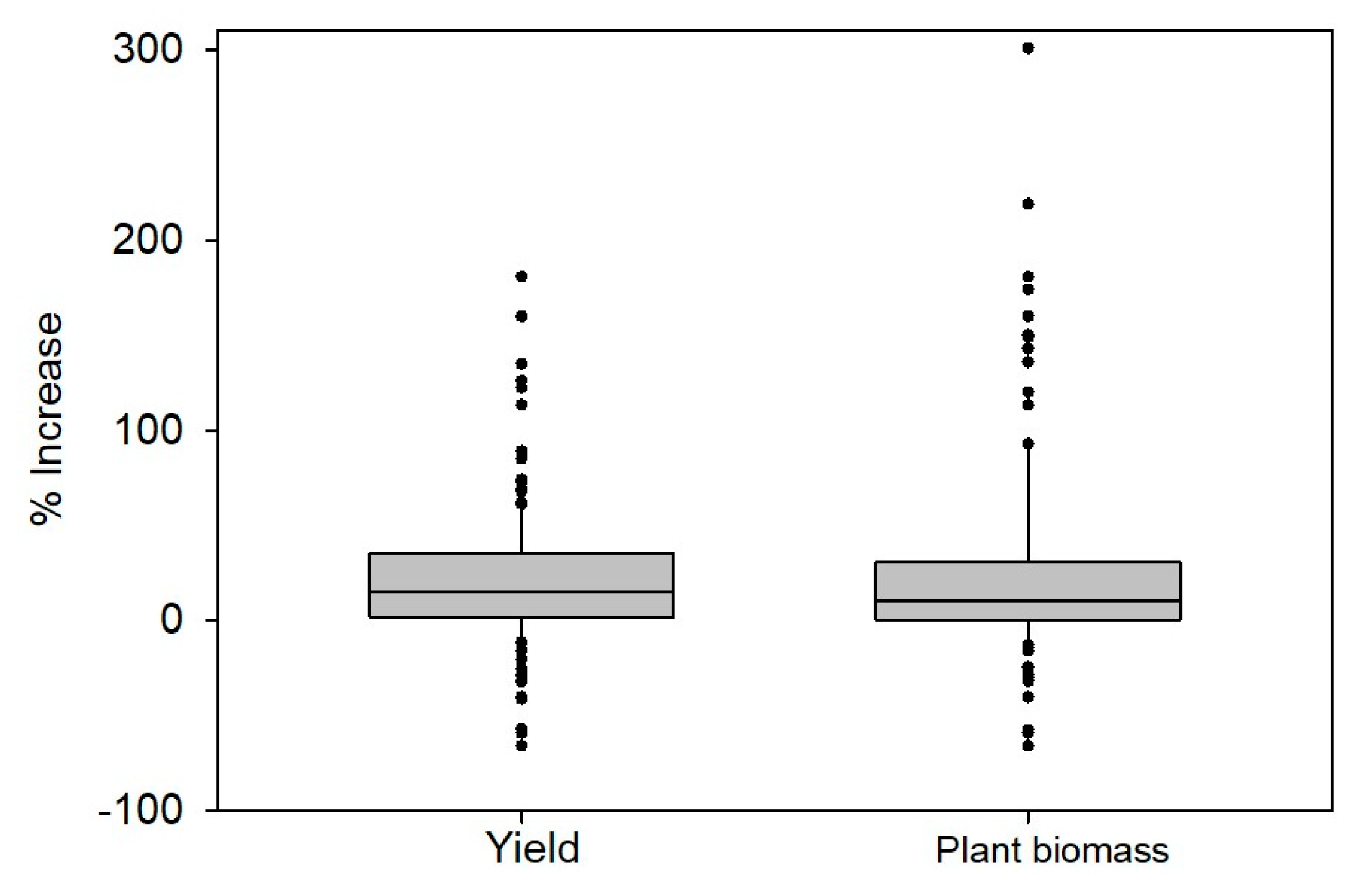
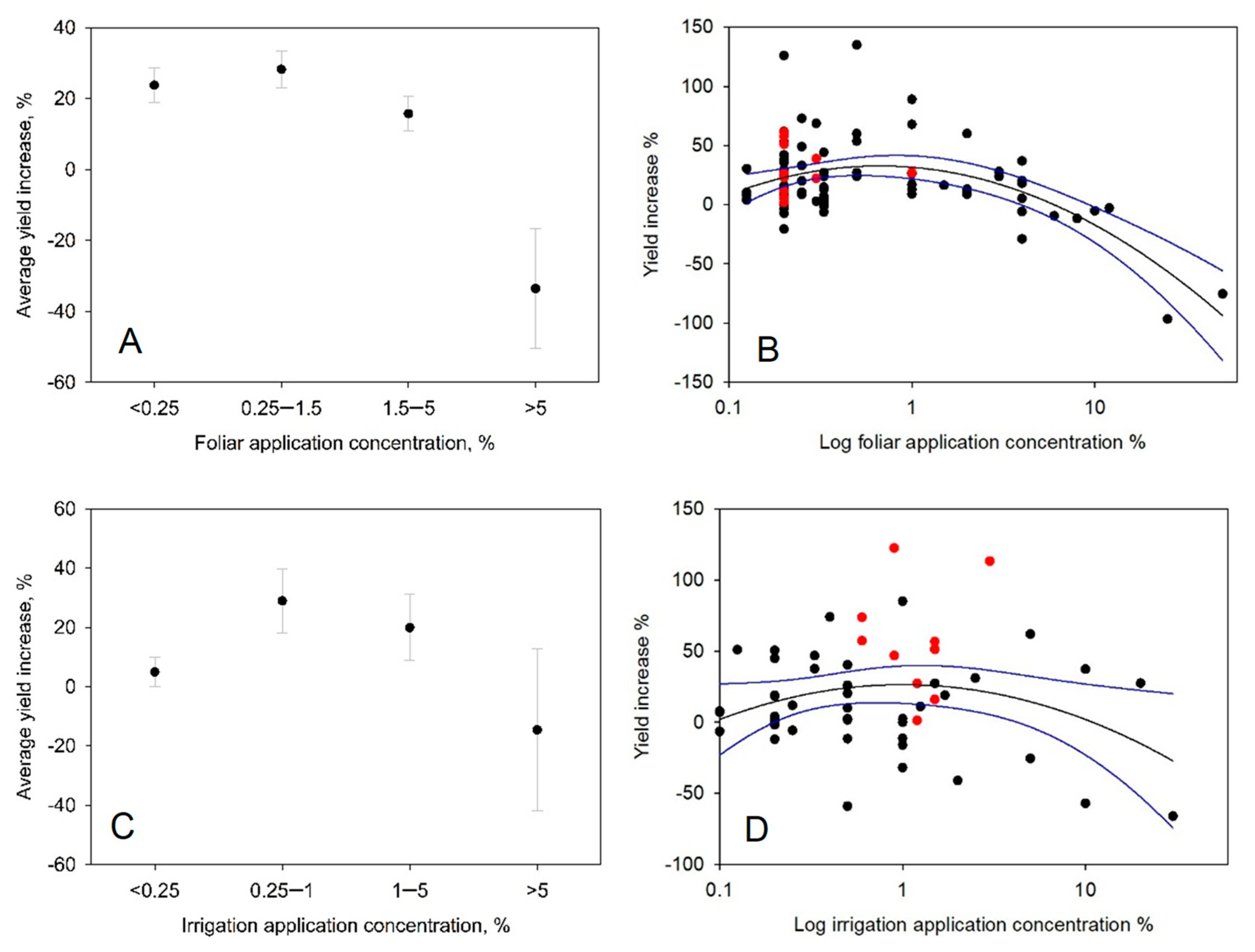

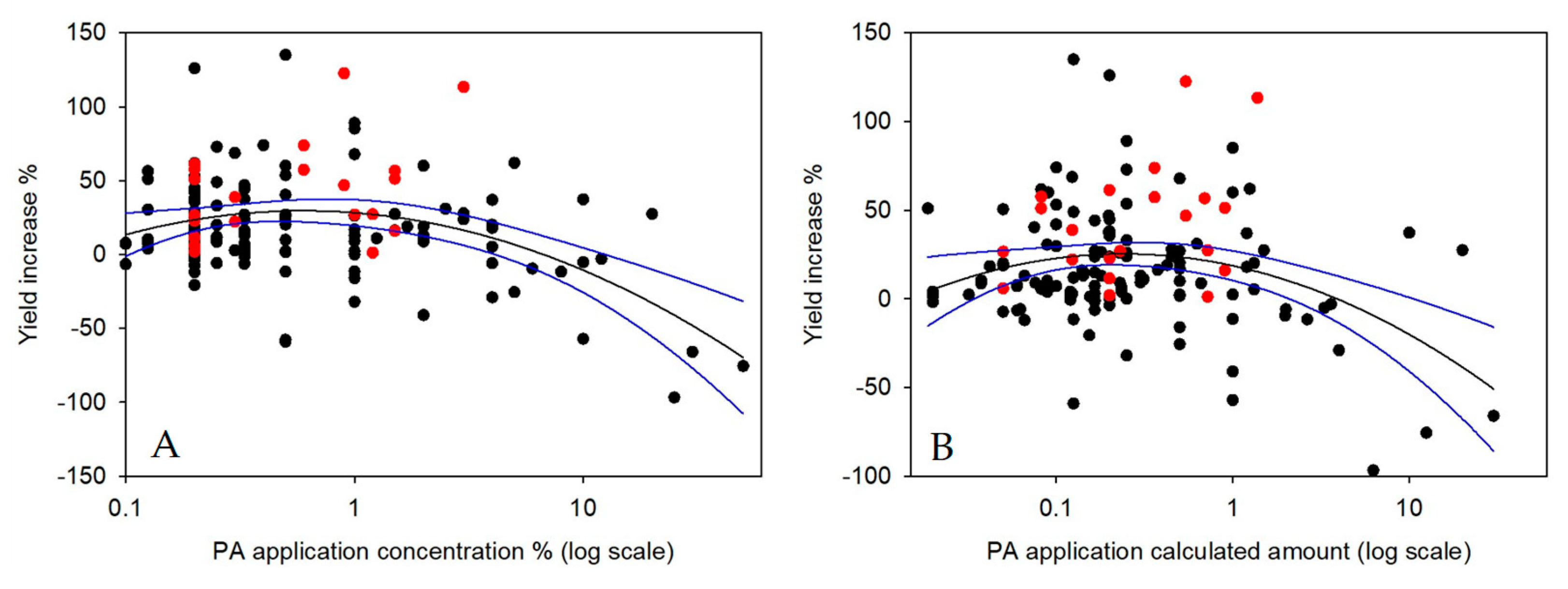
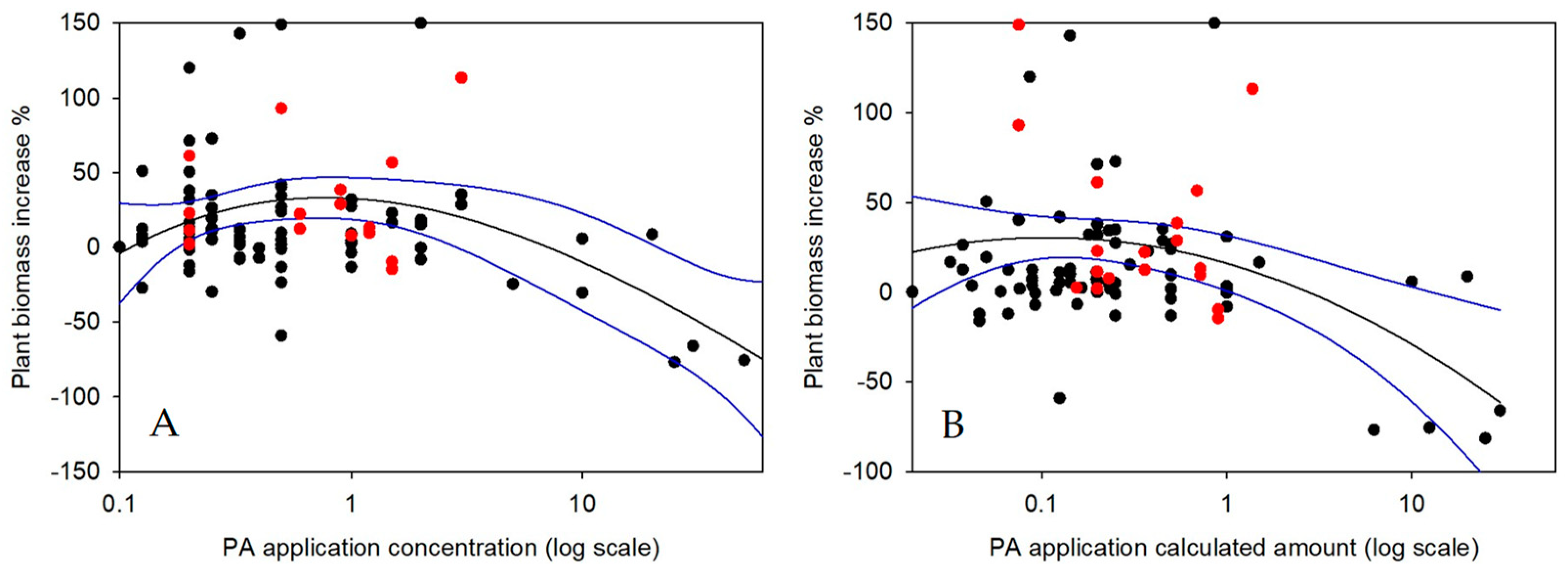

Disclaimer/Publisher’s Note: The statements, opinions and data contained in all publications are solely those of the individual author(s) and contributor(s) and not of MDPI and/or the editor(s). MDPI and/or the editor(s) disclaim responsibility for any injury to people or property resulting from any ideas, methods, instructions or products referred to in the content. |
© 2025 by the authors. Licensee MDPI, Basel, Switzerland. This article is an open access article distributed under the terms and conditions of the Creative Commons Attribution (CC BY) license (https://creativecommons.org/licenses/by/4.0/).
Share and Cite
Leifeld, J.; Walz, I. Pyroligneous Acid Effects on Crop Yield and Soil Organic Matter in Agriculture—A Review. Agronomy 2025, 15, 927. https://doi.org/10.3390/agronomy15040927
Leifeld J, Walz I. Pyroligneous Acid Effects on Crop Yield and Soil Organic Matter in Agriculture—A Review. Agronomy. 2025; 15(4):927. https://doi.org/10.3390/agronomy15040927
Chicago/Turabian StyleLeifeld, Jens, and Iva Walz. 2025. "Pyroligneous Acid Effects on Crop Yield and Soil Organic Matter in Agriculture—A Review" Agronomy 15, no. 4: 927. https://doi.org/10.3390/agronomy15040927
APA StyleLeifeld, J., & Walz, I. (2025). Pyroligneous Acid Effects on Crop Yield and Soil Organic Matter in Agriculture—A Review. Agronomy, 15(4), 927. https://doi.org/10.3390/agronomy15040927






